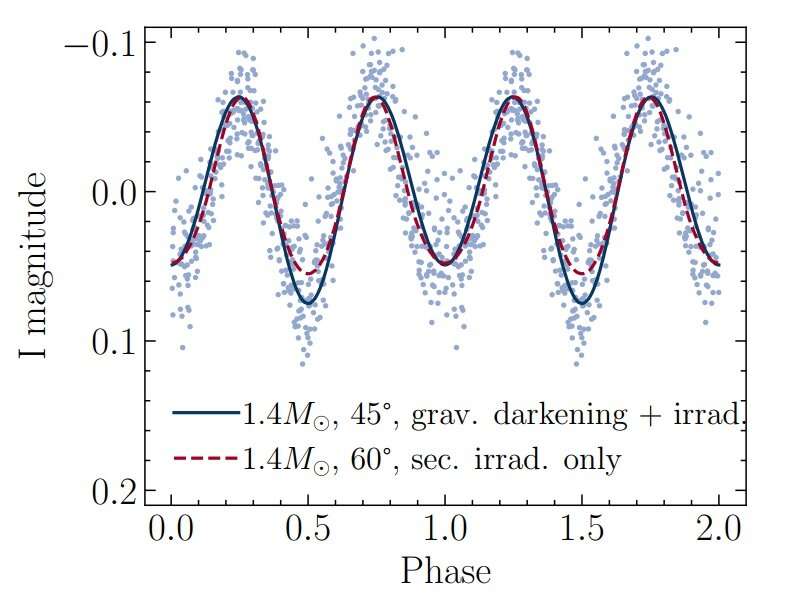October 11, 2022 report
OGLE-BLG504.12.201843 is an extreme dwarf nova, new findings suggest

An international team of astronomers has analyzed the photometric and spectroscopic observations of a candidate cataclysmic variable known as OGLE-BLG504.12.201843. Results of this analysis suggest that this object is an extreme dwarf nova of the U Gem-type. The findings are reported in a paper published October 3 on arXiv.org.
OGLE-BLG504.12.201843 (or O-201843 for short) was first detected in 2015 as part of the Optical Gravitational Lensing Experiment (OGLE). Previous observations of this source have found that it showcases a photometric variability with a period of 0.523419 days (interpreted as an orbital period) and that it undergoes nearly year-long outbursts repeating every 950 to 1,020 days.
The nature of O-201843 is still uncertain, however, taking into account its outburst, the object was initially classified as a candidate cataclysmic variable (CV). In general, CVs are binary star systems consisting of a white dwarf primary that is accreting matter from a normal star companion. They irregularly increase in brightness by a large factor, then drop back down to a quiescent state.
Given that in CVs, mass transfer from the companion star often occurs through an accretion disk around the white dwarf and in some cases thermal instability in the disk triggers an outburst known as a dwarf nova (DN). These novae are a type of CVs that undergo semi-periodic outbursts. Some DNe only experience regular 2–5 mag outbursts (U Gem type) while others display additional features.
When it comes to O-201843, previous studies suggested that its photometry is reminiscent of a DN with extreme properties. Therefore, a group of astronomers led by Camille Landri of the Charles University in Prague, Czech Republic, sought to verify this hypothesis by analyzing the existing optical photometry and new optical spectroscopy, mainly from OGLE and various spectrographs.
The photometric data of O-201843 showcases clear features of an accretion disk from which the outbursts can originate. Moreover, a gradual brightening and small flares were identified in the data during the quiescence period between outbursts. The astronomers interpret this brightening as an increase in the luminosity and temperature of the accretion disk, while the origin of the flares is yet to be determined.
Based on the analysis of the spectroscopic data, it was found that O-201843 shows Balmer absorption that can either come from a bright secondary star or from a cold accretion disk. However, no features of a white dwarf and the usual features of an unstable accretion disk have been observed.
Summing up the results, the researchers noted that O-201843 may be a U Gem-type dwarf nova with extreme properties.
"Altogether, the photometry of O-201843 shows strong similarities with DNe but also important differences. While these peculiarities have not been observed in other DNe, it is possible that O-201843 is an extreme U Gem DN, or at least is somehow linked to DNe.... Due to its extreme properties and peculiarities, OGLE-BLG504.12.201843 is an excellent object for further follow-up studies," the authors of the paper concluded.
More information: Camille Landri et al, OGLE-BLG504.12.201843: A possible extreme dwarf nova. arXiv:2210.01141v1 [astro-ph.SR], arxiv.org/abs/2210.01141
© 2022 Science X Network





















